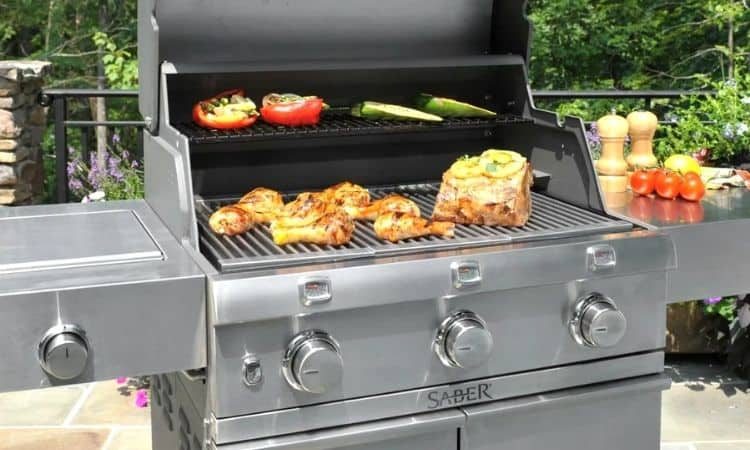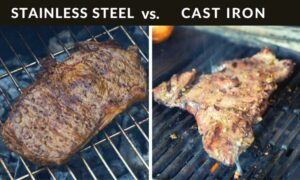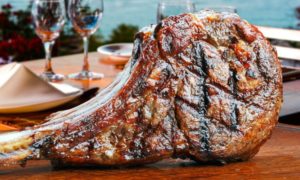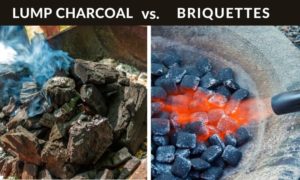Infrared grills have been hitting the barbecue world by storm. But what does this relatively new technology mean for your backyard cookouts?
Let’s take a deeper look at how infrared grills work and what are the pros and cons of these impressive cooking appliances. We will also discuss the differences between regular gas grills and infrared grills.
How Do Infrared Grills Work?
To understand how infrared grill systems work, it’s important to know what makes them different from your typical gas grill. And it also helps to understand a little bit of physics.
Don’t worry — the physics class will be short today.
What you really need to know, is that there are three basic ways to transfer heat from one object to another:
- Conduction: This is the transfer of heat by direct contact. No matter what kind of grill you have, if your food is sitting on a hot grate, the grate is heating the food via conduction.
- Convection: This is the use of air currents to heat food. In a normal grill, the burner heats the air, and the hot air surrounds the food. The hot air then cooks the food.
- Radiation: Radiation is the basis of how an infrared grill works. The electromagnetic waves emitted by the infrared system heat the food without using the air as a medium for the transfer.
Regular grills work by using gas burners to heat the air. That air gets hot and rises over the food. The hot air not only heats the food but also the inside of the grill.
Unfortunately, a lot of heat is wasted in the process, and it can take as long as 20 minutes to get your grill up to maximum temperatures.
In the end, this is precisely how your home oven cooks, too. The only difference is that on a grill, the grates get hot and provide a component of direct conduction cooking, too. That gives you that great sear and fantastic grill marks.
An infrared grill heats intensely directly above the burner. It doesn’t bother so much heating the rest of the grill, so it preheats much faster and operates more efficiently than a conventional burner.
That also means that an infrared burner can get much hotter.
Types of Infrared Burners
There are two main types of infrared burners that you’ll find available today:
Ceramic Burner Systems
The most common types of infrared burners you will find are made of porous ceramic blocks.
The gas and air mixture comes out of the holes in the ceramic block evenly and is burned over the entire surface. Above the ceramic plate is a strainless grate or mess that holds the food above the burner.
The temperature range of infrared grills with ceramic burners is typically about 600 to 1000 degrees. This means they get extremely hot but can’t be kept at lower temperatures.
Brands that use ceramic burners:
- Solaire is a high-end brand that offers many types models with infrared burners. They have built-in, standalone, and portable infrared grills, some are all infrared and some are hybrid with also regular gas burners.
- Lynx is another premium brand with both all infrared and hybrid grills. Their patented Trident burner technology enables you to also reach lower temperatures (about 300 degrees).
- Napoleon is competitively priced brand with a nice selection of gas grills that come with ceramic infrared rear and side burners.
Emitter Panel Systems
Emitter panels forgo the ceramic burner with a traditional-looking burner mounted under an emitter panel. The burner heats the panel hot enough to produce infrared radiation. Above the emitter panel is a grill grate for cooking.
Brands that use emitter panel systems:
- TEC grills use emitter panels made of glass. They usually have temperature range of around 200-900 degrees.
- Saber has wide range of infrared grills that have metal emitter panels and reach temperatures up to 650 degrees.
- Char-Broil infrared grills are affordable and use TRU-Infrared technology with stainless steel emitter plates.
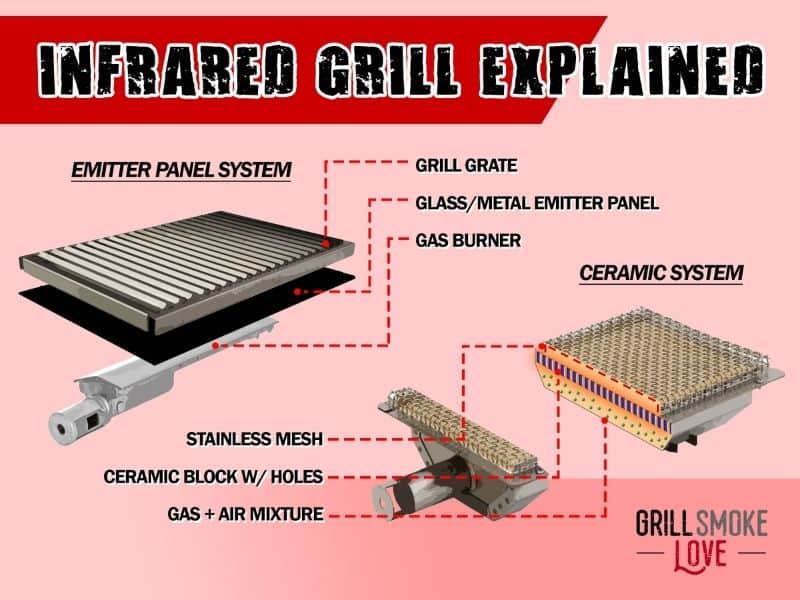
Advantages of Infrared Grills
Infrared grills are wonders of modern grill technology, but they have some pluses and minuses like every new toy.
So first, let’s look at some reasons to love infrared grills.
Searing Power
If infrared has one superpower, it’s that it can sear food as no other heat source can. These burners can get super hot — sometimes more than 1,200 degrees Fahrenheit!
Nearly all of them can get above 800 degrees, which means that even less expensive infrared grills can put a great sear on your steaks.
Fast Heating
Infrared burners heat fast. Since they aren’t wasting energy heating the air and the rest of the grill, you can get the cooking surface up to 800 degrees or more in less than five minutes.
Tastier, Jucier Food
If we’re just talking about serious grill food — steaks, for example — then an infrared burner is where it’s at. The great searing and fast heating mean that juices and flavor are locked in perfectly.
With a bit of practice and a high-quality infrared burner, your grilling game will match the priciest steakhouses in town.
Even Heating with Fewer Hotspots and Flareups
Standard burners heat the various metals above them unevenly. Plus, traditional burners by design don’t spread their heat out much. When you put those two factors together, you have a recipe for hot spots.
However, if you look at the best infrared grills, they use very broad panels to distribute the heat right from the source. So as the heat radiates out of the burner, it will do so evenly and consistently.
Goodbye, hot spots!
The intense heat also means that any drippings will vaporize instead of resulting in annoying and dangerous flare-ups.
What Are the Disadvantages of Infrared Grill Cooking?
It’s not all good news for backyard grill masters, however. There are some downsides to infrared burners, and they are significant enough that you might want to consider sticking with conventional gas grills for the time being.
Can’t Slow Cook
The biggest problem with these new grill designs is that they can’t really be set for low and slow cooking.
Many people enjoy using their backyard grill as a replacement for their indoor oven. That means they like to use it for indirect cooking, even baking.
In addition, you can use many gas grills as makeshift smokers. With a bit of practice, you can get them to hold temperatures as low as 225 or 250 degrees Fahrenheit.
These are things that infrared grills don’t do well. Indirect cooking, by definition, works off the principle of convection. So to accomplish it, you’ve really got to have a conventional gas burner.
This is the precise reason that many grill makers have created hybrid grills. They put infrared burners in sear stations or rear rotisserie burners but leave the rest of the grill with conventional gas burners. That’s the perfect setup for most backyard cooks who see their patio grills as the ultimate “multi-tasker.”
So if your grill recipes are limited to steaks and burgers, an infrared-only grill might be perfect. If you occasionally throw bread or roasts in there, too, you might want to consider a hybrid option.
Can Be Expensive
When infrared technology was invented by TEC grills back in the early 1960s, it was protected by a patent and used only in TEC’s high-end grills. It was an expensive technology that few backyard cooks even knew existed, much less could afford.
The patent has expired, and many companies now offer infrared designs. Even big-box retail brands like Char-Broil use infrared technology, or some derivative of it, to get your steaks sizzling faster.
So there’s a lot more competition in the marketplace nowadays. But the manufacturing process and the complexity of the design for infrared grills are still higher than conventional gas grills.
While there are some bargains to be had, infrared is still an expensive add-on when you’re grill shopping.
If you are looking for an affordable infrared grill, check out our guide with best infrared grills under 500 dollars.
Cleaning Can Be Tedious
Generally speaking, infrared grills should actually be easier to clean. So why is it showing up as one of the disadvantages of infrared grill models?
Simply because it doesn’t apply to them all. For example, a grill with exposed ceramic burners can easily be clogged. The same goes for radiation panels and cooking grates that are purpose-built for infrared technologies.
Like all grills, you will have to do a certain amount of cleaning and preventative maintenance. While most grills can function just fine when a little gunked up, some infrared grills are far more finicky.
Of course, it all depends on the quality of construction and the precise design your grill uses, but you don’t want to be replacing expensive infrared heating elements regularly.
Infrared Versus Traditional Gas Grills
Here are the primary differences between conventional and infrared grills:
Heating Method: This is the fundamental difference between infrared and regular gas burners. Infrared heats food directly via radiation, and regular burners heat the air around food via convection.
Temperature Range: Infrared burners are intensely hot, and most don’t set to low very well. So conventional grills can often hold temperatures as low as 200 degrees Fahrenheit, while infrared grills cannot go much below 300 degrees Fahrenheit.
Cooking Time: Because of the higher heat involved, infrared cooking times will be much less than conventional grills. Preheat times are also much shorter.
Fuel Consumption: Infrared burners use more fuel than conventional burners, especially when set to high power. But because they are left on for shorter lengths of time, you will probably end up consuming less gas.
Price: No matter how you cut it, infrared burners are more expensive. They are both a newer, premium technology and more complex to manufacture. So even though infrared grills have been on the market for quite a while, the price is still higher than regular burners.
Conclusion
Infrared grills are a fantastic technology for backyard grillers who like the perfect sear. But, they’re also great for anyone who likes to grill hot and fast!
It’s an efficient way of cooking, even if it does limit your grill’s utility just a little.

